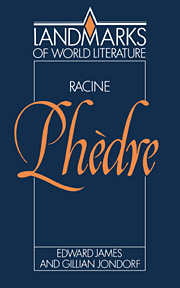2 - Phèdre, the play
Published online by Cambridge University Press: 05 June 2012
Summary
Structure
The structure of Phèdre, as of any regular play of the French seventeenth century, could be described in the terminology of contemporary theorists. Thus Théramène in Li is serving as what Corneille calls a ‘personnage protatique’, an expository character through whose dialogue with the protagonist the audience learns the details it needs for comprehension of the play. The news (III.iii) that Thesee is alive and his return imminent is a ‘péripétie’ or sudden change of fortune, and coming as it does after Phèdre's declaration of love to Hippolyte it constitutes a ‘coup de théâtre’, a sudden dramatic surprise. Such description will show that Phèdre is a well-made play by the standards of its day, but the modern reader will need to know more. We shall look at the structure of the play by considering a number of its elements, including story, characters, setting, time, and imagery.
The story of Phèdre
If we summarise the events which constitute the plot of Phèdre and see how these events are arranged through the five acts of the play (their ‘disposition’, in rhetorical terms), it is clear both that there are no slack passages or empty acts, and that there are elements of symmetry and design which make the ‘disposition’ pleasing. The main elements in the plot are distributed among the acts as follows:
Act I – Hippolyte announces his intention of leaving, and admits his love of Aricie to his confidant. […]
- Type
- Chapter
- Information
- Racine: Phèdre , pp. 19 - 88Publisher: Cambridge University PressPrint publication year: 1994



